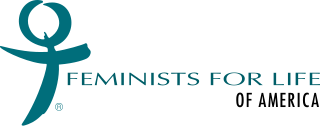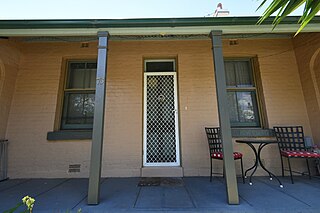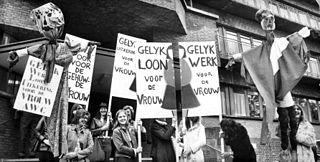Related Research Articles

Feminists for Life of America (FFL) is a non-profit, anti-abortion feminist, non-governmental organization (NGO). Established in 1972, and now based in Alexandria, Virginia, the organization publishes a biannual magazine, The American Feminist, and aims to reach young women, college students in particular.
The women's liberation movement (WLM) was a political alignment of women and feminist intellectualism. It emerged in the late 1960s and continued til the 1980s, primarily in the industrialized nations of the Western world, which resulted in great change throughout the world. The WLM branch of radical feminism, based in contemporary philosophy, comprised women of racially and culturally diverse backgrounds who proposed that economic, psychological, and social freedom were necessary for women to progress from being second-class citizens in their societies.
Marie Tulip was an Australian feminist writer, academic and proponent for the ordination of women as priests.

The Elsie Refuge for women and children was a women's refuge set up in Glebe, Sydney in 1974. The project was the beginning of the NSW Women's Refuge Movement that responded to the needs of women and children escaping domestic violence by providing access to specialist accommodation and support services operating within a feminist framework.
Kathie Sarachild is an American writer and radical feminist. In 1968, she took the last name "Sarachild" after her mother Sara. Kathie coined the phrase "Sisterhood is Powerful" in a flier she wrote for the keynote speech she gave for New York Radical Women's first public action at the convocation of the Jeannette Rankin Brigade. This was a slogan that would become synonymous with the radical feminist movement in the years which followed.

Anne Summers is an Australian writer and columnist, best known as a leading feminist, editor and publisher. She was formerly First Assistant Secretary of the Office of the Status of Women in the Department of the Prime Minister and Cabinet. Her contributions are also noted in The Australian Media Hall of Fame biographical entry
Geoffrey Lancelot Rutter Davis (1933-2008) was an Australian medical doctor, who rose to prominence in Sydney in the 1970s as a leading provider of contraception and abortion services. He was also the owner for nearly 50 years of The Abbey, a 50-room mansion in the Sydney inner suburb of Annandale.
The National Women's Liberation Conference was a United Kingdom initiative organised to bring together activists in the Women's Liberation Movement with the aim of developing a shared political outlook. Ten conferences took place between 1970 and 1978. There was a Welsh conference in 1974 and a Scottish conference in 1977.
Joyce Stevens AM (1928–2014) was an Australian socialist-feminist activist, communist, and historian, one of the founders of the women's liberation movement in Sydney, prominent in the wave of feminism that began in the late 1960s in Australia.
The women's liberation movement in Oceania was a feminist movement that started in the late 1960s and continued through the early 1980s. Influenced by the movement which sought to make personal issues political and bring discussion of sexism into the political discourse in the United States and elsewhere, women in Australia and New Zealand began forming WLM groups in 1969 and 1970. Few organisations formed in the Pacific Islands, but both Fiji and Guam had women affiliated with the movement.

The women's liberation movement in Europe was a radical feminist movement that started in the late 1960s and continued through the 1970s and in some cases into the early 1980s. Inspired by developments in North America and triggered by the growing presence of women in the labour market, the movement soon gained momentum in Britain and the Scandinavian countries. In addition to improvements in working conditions and equal pay, liberationists fought for complete autonomy for women's bodies including their right to make their own decisions regarding contraception and abortion, and more independence in sexuality.

The women's liberation movement in North America was part of the feminist movement in the late 1960s and through the 1980s. Derived from the civil rights movement, student movement and anti-war movements, the Women's Liberation Movement took rhetoric from the civil rights idea of liberating victims of discrimination from oppression. They were not interested in reforming existing social structures, but instead were focused on changing the perceptions of women's place in society and the family and women's autonomy. Rejecting hierarchical structure, most groups which formed operated as collectives where all women could participate equally. Typically, groups associated with the Women's Liberation Movement held consciousness-raising meetings where women could voice their concerns and experiences, learning to politicize their issues. To members of the WLM rejecting sexism was the most important objective in eliminating women's status as second-class citizens.
The women's health movementin the United States refers to the aspect of the American feminist movement that works to improve all aspects of women's health and healthcare. It began during the second wave of feminism as a sub-movement of the women's liberation movement. WHM activism involves increasing women's knowledge and control of their own bodies on a variety of subjects, such as fertility control and home remedies, as well as challenging traditional doctor-patient relationships, the medicalization of childbirth, misogyny in the health care system, and ensuring drug safety.
The NSW Women's Refuge Movement began in 1974 with the establishment of Elsie Refuge in Glebe, NSW. Other refuges were established throughout the 1970s, operating within a feminist framework and responding to the needs of women and children escaping domestic violence. At first, the refuges were developed through volunteer effort and without government funding. Gradually the government took over funding of the refuges, with the states funding the buildings and the federal government funding the running costs. The NSW Women's Refuge Movement continued to provide services to women with diverse needs and to raise awareness about domestic violence.
Population Services International (Australasia) was an Australian based subsidiary of Population Services International. PSI Australasia operated as a not-for-profit corporation, continuously registered in Australia from mid-1973 to 1992, with the mission of providing contraception and abortion services.
The Preterm Foundation was a pioneering not-for-profit family planning clinic in Sydney Australia from 1974 to 2015, offering women a comprehensive range of counseling, contraception and first-trimester pregnancy termination services.
Australia's Royal Commission on Human Relationships was established in August 1974 by Prime Minister Gough Whitlam of the Australian Labor Party (ALP) after the failure in 1973 of the government to pass reforms to the country's abortion legislation.
Lynette "Lyn" Syme (1948-2019) was an Australian political and labor activist, feminist and aboriginal land-rights advocate, recognized in her later years as a Wiradjuri elder of the Dabee people in what is current-day New South Wales.
Louisa Lawson House (LLH) was a mental health centre for women in Leichhardt, New South Wales that operated from 1982 to 1994. Named after Australian feminist Louisa Lawson, it operated as an alternative to mainstream psychiatry, featuring yoga, meditation, conflict resolution training, and anxiety management training. In 1986, the centre opened a minor tranquiliser clinic to help women with withdrawal symptoms from addictive tranquilisers which were in circulation at the time. One division called the "halfway house", launched in September 1985, was a program to provide housing to women with emotional problems, and it was launched with funding from the local department of youth and community services.
Control Abortion Referral Service was a feminist Australian organisation active from 1973 through the mid-1980s that advised and supported women seeking abortion from New South Wales, other Australian states and from abroad, particularly from New Zealand. It also developed new women-run abortion services.
References
- 1 2 3 4 5 Curthoys, Ann (22 February 2012). "Radical Glebe". The Glebe Society. Retrieved 19 December 2023.
- 1 2 3 4 5 6 Magarey, Susan (2014). Dangerous Ideas: Women's Liberation - Women's Studies - Around the World. Adelaide: University of Adelaide Press. pp. 25–29. ISBN 9781922064950. JSTOR 10.20851/j.ctt1t305d7.7 . Retrieved 19 December 2023.
- ↑ Willis, Sue. The Politics of Sexual Revolution. Thesis, Doctor of Philosophy (PhD), University of Sydney, 1981, p. 1.
- 1 2 Mitchell, Grace (25 February 2022). "Hidden from History: The Inner City and Sydney's Second Wave Feminist Movement". Honi Soit. Retrieved 19 December 2023.
- 1 2 Hamilton, Frances (28 September 2020). "The grassroots power of the Women's Liberation Movement". Green Left. Retrieved 19 December 2023.
- 1 2 3 Cooper, Nola (19 December 2023). "The Sydney Women's Liberation Movement 1970 - 1975: Journey through some of the highlights of the Sydney Women's Liberation Movement as recalled by Nola Cooper" (PDF). Women's Health NSW. Retrieved 19 December 2023.
- ↑ Dwyer, Catherine (19 December 2023). "When Bessie Guthrie met the Women's Liberation Movement". 16 Days Blogathon. Retrieved 19 December 2023.
- ↑ Stevens, Joyce (17 October 1972). "ABORTION: Women Speak Out". Tribune (Sydney, NSW). p. 6. Retrieved 19 December 2023.
- ↑ "Women's Commission Plans". Tribune (Sydney, NSW). 30 January 1973. p. 12. Retrieved 19 December 2023.
- ↑ "WOMEN'S COMMISSION". Tharunka (Kensington, NSW). 6 March 1973. p. 4. Retrieved 19 December 2023.
- ↑ "Women's Commission plans". Tribune (Sydney, NSW). 30 January 1972. p. 12. Retrieved 17 December 2023.
- ↑ "Women's Commission". Tharunka (Kensington, NSW). 6 March 1973. p. 4. Retrieved 17 December 2023.
- ↑ "Women's Commission March 17–18". Tribune (Sydney, NSW). 27 February 1973. p. 7. Retrieved 17 December 2023.
- ↑ Lenga, Pauline (17 April 1973). "WOMEN'S COMMISSION 1973". Tharunka (Kensington, NSW). p. 2. Retrieved 19 December 2023.
- ↑ "ABORTION LAW PROTESTS". Tribune (Sydney, NSW). 3 July 1973. p. 12. Retrieved 19 December 2023.
- ↑ "Womens Health Centre - Leichhardt". Tharunka (Kensington, NSW). 6 March 1974. p. 5. Retrieved 19 December 2023.
- ↑ "Contraception and abortion service". Tharunka (Kensington, NSW). 20 July 1975. p. 20. Retrieved 19 December 2023.
- ↑ Alysen, Barbara (6 November 1973). "ABORTION: 'LEGAL' OR ILLEGAL?". Tribune (Sydney, NSW). p. 6. Retrieved 19 December 2023.
- ↑ "ZAPPING THE POPE or Women's Abortion Action Committee formed on campus". Tharunka (Kensington, NSW). 31 October 1973. p. 2. Retrieved 19 December 2023.
- ↑ Robertson, Mavis (13 November 1973). "ARTICLES ON WOMEN: COMMENT". Tribune (Sydney, NSW). p. 10. Retrieved 19 November 2023.
- ↑ "Girls bashed". Tribune (Sydney, NSW). 13 November 1976. p. 6. Retrieved 19 December 2023.
- ↑ "WOMEN TO MEET ON ACTU-EVE ALTERNATIVE". Tribune (Sydney, NSW). 28 August 1973. p. 4. Retrieved 19 December 2023.
- ↑ "WOMEN'S ACTION". Tribune (Sydney, NSW). 11 December 1973. p. 12. Retrieved 19 December 2023.
- ↑ "SOCIALIST WOMEN: OCTOBER CONFERENCE PLANS BEGIN". Tribune (Sydney, NSW). 11 June 1974. p. 12. Retrieved 19 December 2023.
- ↑ "SOCIALIST WOMEN: NATIONAL CONFERENCE AGENDA". Tribune (Sydney, NSW). 23 July 1974. p. 9. Retrieved 19 December 2023.
- ↑ "WOMEN: FRENCH FEMINIST AT CONFERENCE ON ABORTION, CONTRACEPTION". Tharunka (Kensington, NSW). 4 June 1975. p. 8. Retrieved 19 December 2023.
- ↑ "THE CAULDRON". Tribune (Sydney, NSW). 10 March 1976. p. 10. Retrieved 19 December 2023.
- ↑ "Directory". Tribune (Sydney, NSW). 26 September 1977. p. 7.
- 1 2 3 ABORTION: OUR BODIES, THEIR POWER (PDF), 1977, p. 12, retrieved 17 December 2023
- 1 2 Garton, Gloria (7 March 1979). "SYDNEY'S SECOND FEMINIST ABORTION CLINIC". Tribune (Sydney, NSW). p. 6. Retrieved 21 December 2023.
- ↑ "THE CAULDRON". Tribune (Sydney, NSW). 16 February 1977. p. 8. Retrieved 20 December 2023.
- ↑ "Budget will bring new welfare cuts". Tribune (Sydney, NSW). 13 July 1977. p. 11. Retrieved 20 December 2023.
- ↑ "WOMEN COP IT AGAIN". Tribune (Sydney, NSW). 24 August 1977. p. 3. Retrieved 20 December 2023.
- ↑ "Multilingual abortion booklet launched". Tribune (Sydney, NSW). 2 August 1978. p. 2. Retrieved 20 December 2023.
- ↑ "Working Women's Charter Campaign". Tharunka (Kensington, NSW). 28 May 1979. p. 10. Retrieved 20 December 2023.
- ↑ "Happenings". Tharunka (Kensington, NSW). 28 May 1979. p. 10. Retrieved 20 December 2023.
- ↑ "THE CAULDRON". Tribune (Sydney, NSW). 6 June 1979. p. 8. Retrieved 20 December 2023.
- ↑ "Many groups attend women's conference". Tharunka (Kensington, NSW). 5 March 1979. p. 2. Retrieved 20 December 2023.
- ↑ "Women's Liberation House Fete". Tribune (Sydney, NSW). 7 November 1979. p. 8. Retrieved 20 December 2023.
- ↑ "A WOMEN'S LIBERATION CONFERENCE COMING UP". Tharunka (Kensington, NSW). 28 May 1979. p. 3. Retrieved 20 December 2023.
- ↑ "THE CAULDRON". Tribune (Sydney, NSW). 30 May 1979. p. 8. Retrieved 20 December 2023.
- ↑ "Women are hit hardest". Tribune (Sydney, NSW). 5 March 1980. p. 10. Retrieved 20 December 2023.
- ↑ "International Women's Day". Tribune (Sydney, NSW). 24 February 1982. p. 2. Retrieved 20 December 2023.
- ↑ "International Women's Day". Tribune (Sydney, NSW). 3 March 1982. p. 7. Retrieved 20 December 2023.
- ↑ "Women's Page". Woroni (Canberra, ACT). 1 April 1982. p. 7. Retrieved 20 December 2023.
- 1 2 "What's On". Tribune (Sydney, NSW). 5 May 1982. p. 14. Retrieved 20 December 2023.
- ↑ "Women Behind Bars". Tharunka (Kensington, NSW). 15 August 1983. p. 7. Retrieved 20 December 2023.
- ↑ "No Title (photo)". Tribune (Sydney, NSW). 6 February 1985. p. 15. Retrieved 20 December 2023.
- ↑ "Pattern of right-wing attacks grows". Tribune (Sydney, NSW). 20 March 1985. p. 2. Retrieved 20 December 2023.
- ↑ "What's On". Tribune (Sydney, NSW). 18 May 1988. p. 10. Retrieved 20 December 2023.
- ↑ "What's On". Tribune (Sydney, NSW). 1 March 1989. p. 10. Retrieved 20 December 2023.
- ↑ Freney, Dennis (23 August 1989). "Pro-Choice forces rally to defeat Webster Bill". Tribune (Sydney, NSW). p. 3. Retrieved 20 December 2023.
- ↑ "What's On". Tribune (Sydney, NSW). 26 December 1990. p. 10. Retrieved 20 December 2023.
- ↑ "Women's Department". Tharunka (Kensington, NSW). 8 April 1991. p. 39. Retrieved 20 December 2023.
- ↑ "Women's Events". Tharunka (Kensington, NSW). 7 May 1990. p. 24. Retrieved 20 December 2023.
- ↑ "New premises for Women's Liberation House". Green Left. 26 November 1997. Retrieved 20 December 2023.